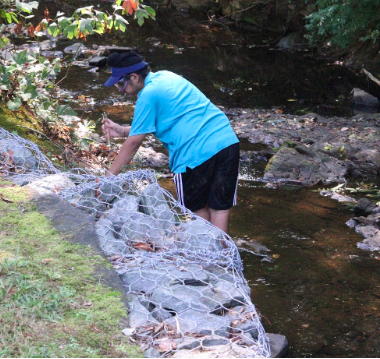New Streams IBET begins work
Students in the newest IBET tackle environmental problems facing streams

Jawand Singh observes a stream, collecting a water sample to study later. The streams IBET will take multiple trips to streams in the area to collect data and find areas of interest for their research projects. “We are gonna be analyzing ecologies of streams in the area and we will be doing that by analyzing the pH and by counting microorganisms,” freshman Lynn Tao said.
November 9, 2019
The new Streams IBET for the 2019-20 school year run by Dr. Kathleen Morrow, Julia Litchford, and Erinn Harris aims to focus on the issue of stream health. Freshmen in this IBET will conduct their study by collecting water samples from local streams to identify what factors affect stream health. Modified from last year’s REASON/Environmental Solutions project, this project is biology teacher Dr. Kathleen Morrow’s way to help the local environment and community, as well as giving her students the opportunity to do hands-on research .
“I found that [the previous project] was a bit broad, and made it a little bit difficult for the students to hone in on a more specific and simple research question. And so I wanted to make it a little bit more precise this year.” Morrow said.
In short, her 20 IBET groups will collect data from 20 different local streams, studying their biodiversity and health factors. Morrow is hopeful that this project will finally give students a chance to go outside, and be a part of their environment in an age where they spend their lives inside, studying through screens.
“When I was a kid, and I know it sounds really corny, I loved to just go out on the weekend and get dirty and muddy and play with salamanders and frogs, and this kind of project would have been so exciting to me,” Morrow said.
Because there aren’t many projects these days requiring students to be hands-on with the environment that they are studying, the IBET project might seem like an especially daunting task.
“I know we are doing something related to stream ecology, and I heard difficulty varies depending on your teachers and who is in your IBET group,” streams IBET freshman Lynn Tao said.
Unknown by these students, their IBET projects are actually involved with something on a much larger scale. The success of their projects have impacts greater than they may realize.
“We are actually acting a bit as the guinea pigs for what might become a national campaign to bring stream assessments and water quality assessments to high schools all across the country,” Morrow said.
This project also give students an opportunity to use some of Jefferson’s many resources.
“It’d be really nice if we could work together in a way to build a program where we can utilize some of the higher level laboratory equipment that we have at TJ to ask some molecular questions about these streams, and even potentially find bio indicators of health or environmental impacts in these streams,” Morrow said.
Students have already begun to ask questions about these streams, coming up with ideas for their project.
“Our group was thinking about focusing on anthropogenic pollution. And how distance will affect macroinvertebrate diversity,” Tao said.
Dr. Morrow hopes that her students may develop independent research projects will hopefully address some of the more specific concerns in this area such as the amount of salt inundation from the roads.
“In an ideal world, they might get so excited about this type of research that they might try to do something in the jump lab for a science fair experiment between the 10th and 11th grade,” Dr. Morrow said. “Even this year we have a group in a senior research lab that’s interested in doing a stream water quality study for their research project, so I’m hoping to see this stepwise build as we get more and more involved with it every year.”





